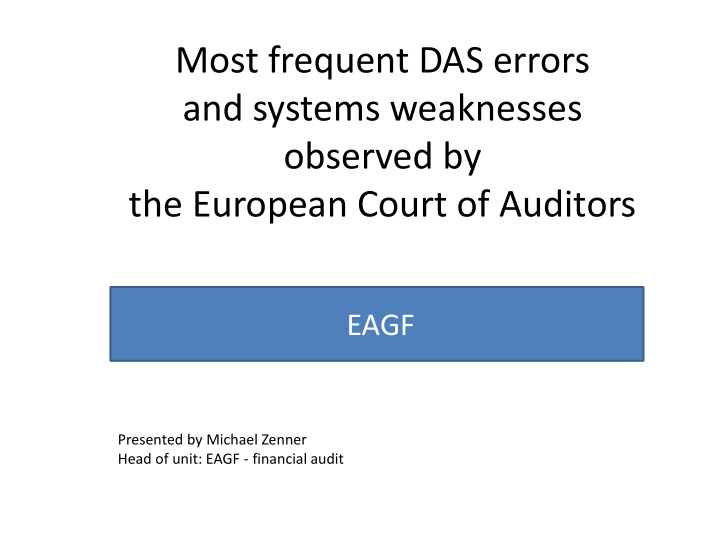



Most frequent DAS errors and systems weaknesses observed by the European Court of Auditors EAGF Presented by Michael Zenner Head of unit: EAGF - financial audit
Important Notice: The following presentation is a personal analysis of the author and does not engage the European Court of Auditors.
DAS and types of errors • The Court’s DAS sample for EAGF: – Total sample: 180 randomly selected payments – around 150 IACS and around 30 NON IACS • Categories of errors relevant for the Court’s error rate (quantifiable errors) – Accuracy errors: Beneficiary, Land and Operation were eligible but amount of payment was incorrect; – Eligibility errors: Beneficiary, Land or Operation were not eligible – Occurrence error: The operation underlying the aid payment did not occur
Most frequent accuracy errors 1. Ineligible land recorded as permanent grassland 2. Incorrect value of entitlements 3. Incorrect application of obvious error concept 4. Other
Categories of errors Administrative errors: 40% Permanent grassland: 27% Other errors: 33%
The error N° 1: Permanent pasture • Before introduction of SPS permanent grassland was not itself eligible for EU area aid. • But it was necessary to support EU animal premium (Maximum Stocking Density). • When direct aid was decoupled the number of entitlements allocated was calculated on the basis of the total reference area including forage area. • Around 25% of all DAS errors relate to incorrect assessment of grassland.
The error N° 1: Permanent pasture • In order to maintain the historical level of aid farmers must activate all entitlements allocated, i. e. they need to declare all land including the forage area. • Given that forage areas now generate EU area aid themselves they are to be assessed against the eligibility criteria set in EU legislation.
The error N° 1: Permanent pasture Current Legislation: • EU legislation defines permanent pasture as land used to grow grasses or other herbaceous forage naturally or through cultivation • Grasses or other herbaceous forage are all herbaceous plants traditionally found in natural pastures or normally included in mixtures of seeds for pastures or meadows in the Member States whether or not used for grazing animals.
• The soil cover makes the difference……..
• The soil cover makes the difference……..
The soil cover makes the difference……..
The soil cover makes the difference……..
The soil cover makes the difference……..
• The soil cover makes the difference……..
• The soil cover makes the difference……..
The error N° 1: Permanent pasture • The current proposal for CAP post 2013 Reform: “ Member States may decide to include land which can be grazed and which forms part of established local practices where grasses and other herbaceous forage are traditionally not predominant in grazing areas ”
Incorrect value of entitlements • Ceiling overshoot: Ceiling for SPS is expressed in terms of total value of all entitlements allocated and not in terms of entitlements activated (claimed for payment) or SPS payments . • Linear increases of all entitlements by use of funds available in the national reserve
Incorrect application of obvious error concept • Avoidance of aid reductions and penalties in cases of double claimed parcels by replacing the parcel in one application by an new (unclaimed) parcel of a different size and shape and in a different (remote) location.
Parcel claimed before obvious error correction
Parcel claimed after obvious error correction
4. Other • CC infringements – No GAEC maintenance – Nitrate directive obligations not respected – Animal identification (missing ear tags, no or incorrect records in herd book, incorrect or incomplete data in databases) • Incorrect payment algorithm • Non respect of tendering requirements • POSEI: Overdeclaration of animals
The EU farmer definition: A farmer is a person carrying out an agricultural activity. An agricultural activity can be a classical production activity or a maintenance activity Under the current EU law there is no priority for production activity over pure maintenance in terms of eligibility; as a result the person carrying out a production activity is not necessary entitled to EU aid.
• Beneficiary of EU aid Letting agreement: You may farm my land and take care • Farmer of GAEC (on my behalf )……… but I claim EU aid
Systems weaknesses LPIS/GIS data • Not based on ortho images • based on incorrect interpretation of ortho- images, • based on out of date ortho – images • Not updated by results of OTS inspections • No rapid field visits for unclear RS cases
Systems weaknesses • Missing or unreliable audit trail (Who changed what and when and who validated it?) • Administrative procedures with insufficient “built in” control for sensitive issues. operations with financial implications can be done and validated by the same official (no separation of duties). • No remedial action in cases of weaknesses (ECA reports the same weaknesses over several years)
Thank you for your attention Questions?
Recommend
More recommend